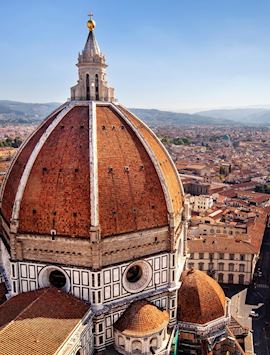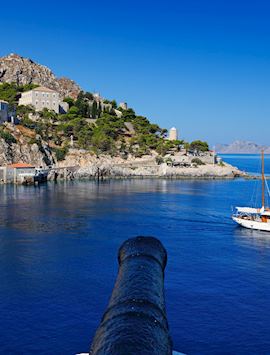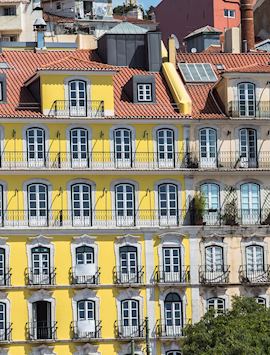From hiking over the twisted lava flows of Iceland to exploring the sun-drenched ruins of Greece, you can spend years exploring Europe’s cities, villages, and landscapes. If this is your first time planning a trip to Europe, you may want to focus on the highlights, like a double-decker bus ride through London, as well as include less-common tours, like seeing Rome from the back of a classic Vespa.
Or you might choose to explore thematically and have your specialist build a trip around your specific interests. A culinary journey might introduce you to local winemakers in France and Croatia, include a pretzel-making class in Bavaria, or see you eating “Viking sushi” still dripping from the North Atlantic.
Below, we've spotlighted Europe trip ideas that our clients have particularly enjoyed, using routes that work well. Whether you’re looking for a deep dive into Renaissance art or a chance to explore several ancient capitals, we can plan a trip that’s exactly what you’re looking for.
1. London, Paris & Rome
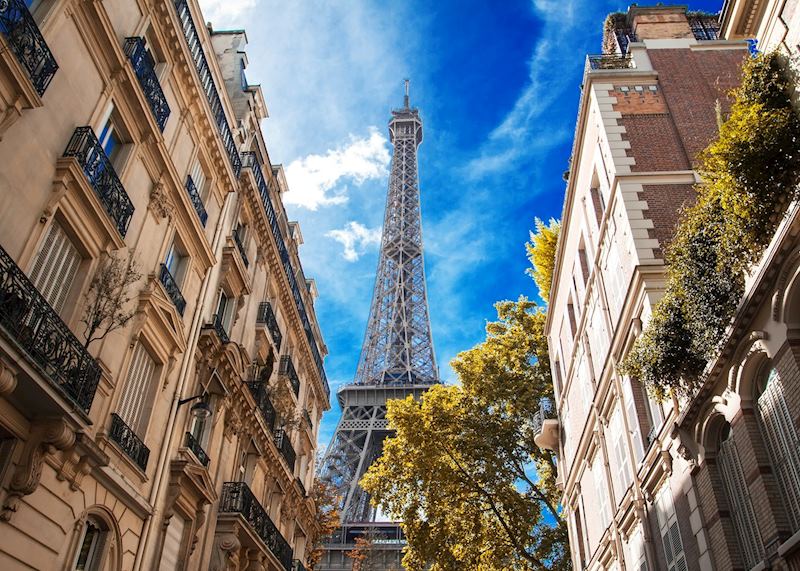
If you're planning a trip to Europe for the first time, visiting London, Paris, and Rome offers a great introduction to the highlights of the continent. These three cities are some of the best places to delve into European history in the places where it happened, from the ancient ruins of the Colosseum to the medieval Tower of London to the modern masterpiece of the Eiffel Tower.
Where the trip could take you:
All three cities have international airports with excellent connections, so it’s easy to hop between them. For example, a nonstop flight between Paris and Rome takes less than two hours. Paris and London are also connected by the Eurostar, a high-speed train that can whisk you between the two capitals.
Experiences you can have:
Expert guides provide new perspectives to recognizable sights in each city. You might visit Westminster Abbey and Buckingham Palace, St Peter’s Basilica and Notre Dame, as well as the Louvre Museum and Palace of Versailles.
We can also arrange for you to experience some of the foods the cities are known for. Take afternoon tea while riding one of London’s classic double-decker buses, make a traditional baguette with a master baker at a boulangerie, or take a walking food tour through Rome’s Campo de' Fiori and the Jewish Ghetto.
Oenophiles can add short visits to vineyards in France and Italy. You can sip Champagne at a small, family-run operation just a short drive from Paris, or include several days in any of the countries’ wine regions, including the Loire Valley, Châteauneuf-du-Pape, Tuscany, or Barolo.
2. Rome, Venice, Florence & Tuscany

Planning a first-time trip to Italy is complicated by the wealth of options, but a visit to the art cities — Rome, Venice, and Florence — is a great introduction to the country. There, you can delve into the ancient history of the Romans at the very seat of the empire and see Renaissance masterpieces in the settings that inspired their formation, like Michelangelo’s Creation of Adam on the ceiling of the Sistine Chapel.
Where this trip might take you:
You could choose to start your trip in Rome, Venice, or Florence, moving from one city to the next in a circular route. Thanks to the robust train network, you can catch high-speed trains between all three. From Florence, it's easy to reach Tuscany’s countryside and medieval towns.
Experiences you can have:
We can connect you to local experts who’ll take you on private tours through these renowned sights. They’ll uncover hidden corners you didn’t know existed — including a behind-the-scenes look at the secret chambers of the Doge’s Palace in Venice — as well as provide insights into renowned artworks.
The route also includes plenty of opportunities to indulge in Italy’s regional cuisines. You could hunt for truffles in the Tuscan countryside, make pasta in a private cooking class, or sip Chianti in a converted 11th-century monastery.
To dig more deeply into Rome’s long history, we can arrange a guided visit to the Basilica of San Clemente. This 12th-century church was erected over the 4th-century ruins of the previous basilica, which was itself built on a temple to Mithras.
3. Southern Italy & the Amalfi Coast
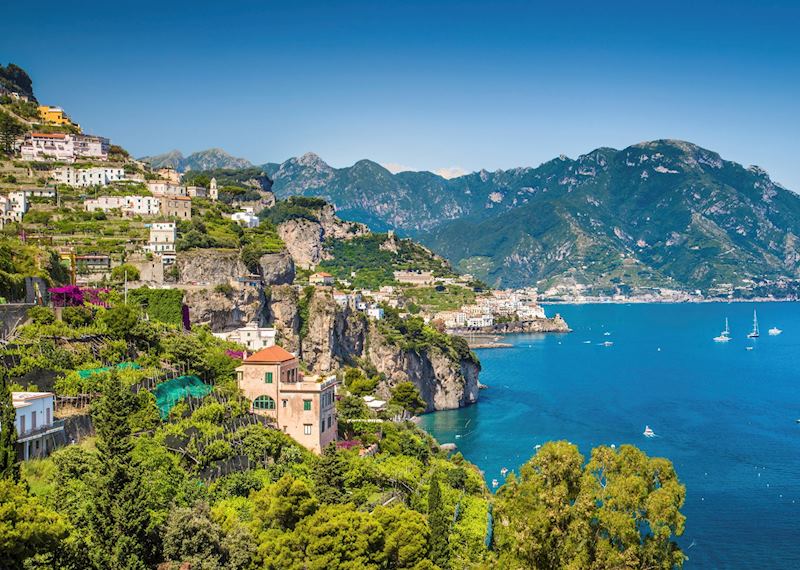
With cliffside villages, glittering coastlines, and ample sunshine, Southern Italy is a destination ripe for leisurely exploration. If you’re planning a trip here, you can idle away your time in the glamorous villages of the Amalfi Coast and sip wine on the deck of a private yacht while cruising through the hidden coves of Capri. It's also the best place to see ancient Roman cities, perfectly preserved by a long-ago eruption.
Where this trip might take you:
The Bay of Naples is bracketed by its eponymous city in the north and the jutting Sorrento Peninsula at the south. Just off the peninsula's tip is the glamorous island of Capri and along the southern side, sits the sun-drenched Amalfi Coast, with its many tiny villages looking out over the glittering gulf of Salerno. Slightly inland, you’ll find Mount Vesuvius, now a park, as well as Pompeii and Herculaneum, the ancient cities that it destroyed.
Experiences you can have:
To add a new perspective to the sunny scenery, we can introduce you to expert guides who’ll unpack the culture and geology behind the coast and the surrounding region. With them, you could sample street food in Naples, explore the frozen-in-time cities of Pompeii and Herculaneum, and hike the slopes of Mount Vesuvius.
We can also introduce you to some of the people who live here, including Laura, a real Italian nonna who’ll show you how to make regional dishes in her family’s kitchen.
And, of course, there’s getting onto the water to enjoy the views of the coast from a different vantage. We suggest a private boat ride to the island of Capri, with its hidden grottoes — stopping en route for a swim.
Readers of Elena Ferrante’s Neapolitan Novels may want to include a tour of the city’s hidden corners. You’ll explore key locations from the books, starting in the isolated Rione Luzzatti district and ending with a pastry from a local bakery.
4. Italy’s Puglia & Matera
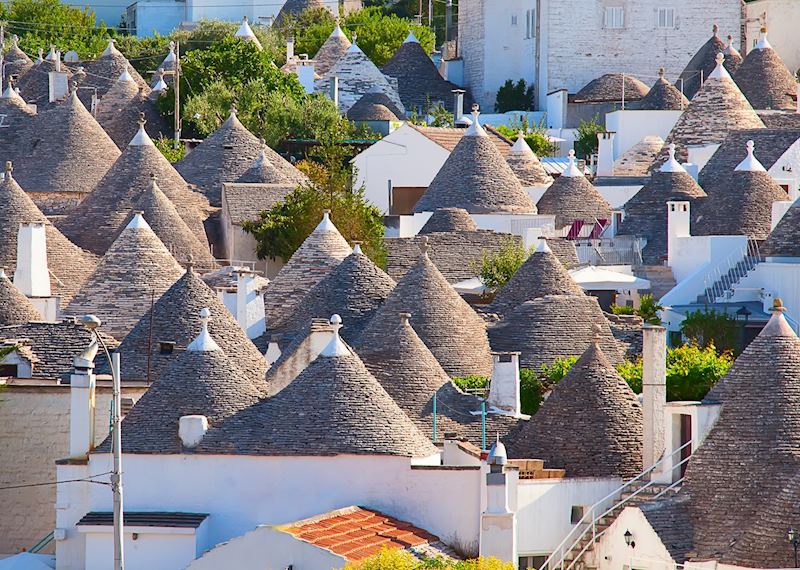
The sunny heel of Italy’s boot, Puglia is one of the best regions to experience the bucolic side of Italy. You’ll be able to drive through sun-baked olive groves, see fields of golden wheat, and glimpse ancient stone buildings, both conical trulli and cave dwellings in nearby Matera. You can while away your time at coastal villages, the Baroque city of Lecce, or at a “masseria”, one of the region’s fortified farmhouses.
Where this trip might take you:
The capital of Puglia, Bari, perches on the coast, while the troglodyte city of Matera is further inland, technically just outside the region's borders. At the very tip of the heel is Otranto, a whitewashed port town that recalls the region’s Greek roots. Between, you’ll find small agricultural villages, coastal towns, and the historic Lecce.
Experiences you can have:
Climbing up and down the stairs in the cave town of Matera, your expert guide can explain the long history of the troglodyte churches and residences. A different guide will help you learn more about the mysterious conical stone houses called trulli that line the streets of Alberobello.
In the Baroque university city of Lecce, you might take a guided cycling through the “Florence of the South” and explore the uniquely flamboyant decor known at “Barocco Leccese”.
There’s also plenty of time to enjoy the coast here, both beaches and seaside towns like Fasano, Polignano a Mare, and Otranto.
Gourmets might include a bread-baking class in Altamura and learn the secrets of a local DOP-protected loaf from a fifth-generation baker. Or you can visit the underground mills in Presicce to learn about the region’s long history as a producer of olive oil.
5. Athens & the Greek Islands
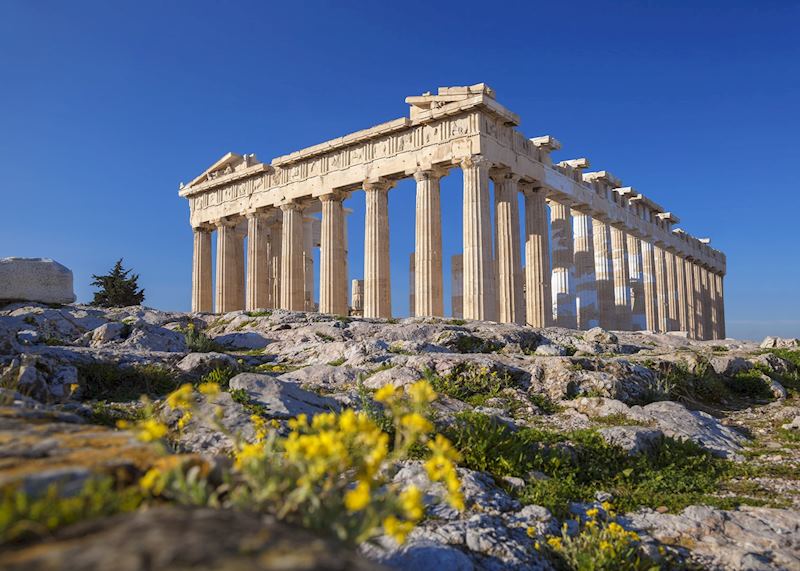
If you’re planning to visit Greece for the first time, a visit to the ancient capital and a handful of the islands offers a great introduction to the classic highlights of the country. On a trip here, you can take a private tour of the Parthenon and its museum, enjoy authentic personal encounters, like a cooking class on the island of Santorini, and relax in the Aegean sun.
Where this trip might take you:
Athens is the starting point of almost any visit to Greece, but from there you can head out to any of the country’s thousands of islands, each with its own personality, history, and beaches. There are ferries from the mainland or, depending on the destination, you can opt for a short flight.
Experiences you can have:
Almost everywhere you go, you can see the classical history that Greece is known for. You might opt for a private tour of Athens’ Parthenon or the island of Delos, once thought to be the birthplace of Apollo and Artemis. Your guides will unpack the complicated history and archaeology behind these sights and offer expert perspectives on the distant past.
We can also introduce you to the people who live in modern Greece. You might share a meal with an Athenian chef, learn to make local dishes from Teta in Mykonos, and explore the small, rarely visited villages of Santorini.
The relaxed atmosphere of the islands means there are plenty of ways to slow down and linger, whether you choose to visit the car-free Hydra or take a trip to the photogenic and bustling caldera-side town of Oia on Santorini.
For a look at more modern Greece, we can arrange a guided tour of Athens’ ever-changing street art. Or you can spend a day cruising around the island of Milos on a private catamaran, exploring the hidden bays where few visitors ever reach.
6. Greece’s Cycladic Islands

With their white-washed, sugar-cube houses and distinctively blue accents, the Cycladic Islands are arguably the most recognizable archipelago in the Mediterranean and an obvious destination for anyone planning a trip to Greece. Here, you can balance exploration and relaxation in equal measure — you might spend the morning exploring an island’s unique geology, and then spend the afternoon lounging on a beach or diving off a private yacht into a remove cove.
Where this trip might take you:
Most trips to Greece start in Athens. The Cyclades are linked by a robust ferry network, so it’s easy to bounce between them. You can opt to visit as many or as few as you like, but we suggest a mix of at least three so you can get a feel for the variety — consider Milos, Paros, and Naxos.
Experiences you can have:
You might join a geologist on a 4x4 tour of Milos’s rugged interior, learning about the volcanic natural history of the rocky island and how it’s influenced the people here for centuries. On Paros, you can take a guided hike down paths laid down in the Byzantine era, visiting the tiny hamlets where visitors rarely go.
Of course, there will still be plenty of opportunities to unwind on the beaches and swim in the Aegean. For example, you might opt to spend a whole day cruising on a private catamaran along the coastlines of the Lesser Cyclades Islands that dot the blue waters off Naxos.
To explore more of the region’s ancient history, you can venture out of Athens to visit the Temple of Poseidon at Cape Sounion. We’ll arrange a guided kayak trip to allow you to see the Sea God’s soaring pillars from the water.
7. Lisbon & Porto
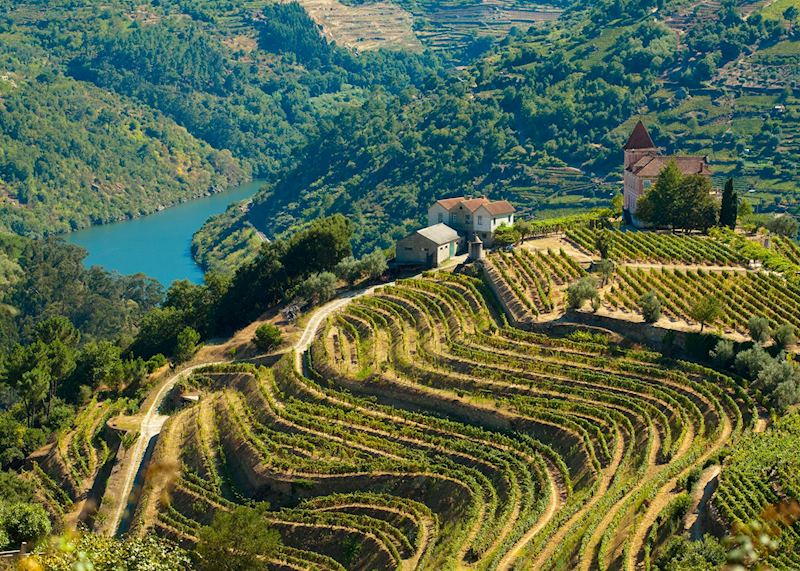
Together, cosmopolitan Lisbon and medieval Porto offer a comprehensive introduction to Portugal’s culture, cuisine, and history. On a trip here, you can spend your time exploring Lisbon’s districts and blue-and-white tiles, listening to Fado performances, and sipping port wine on a Duror River cruise.
Where this trip might take you:
Both Lisbon and Porto boast international airports, and they’re connected by a train, so it’s easy to visit in whichever order you prefer. If you want to venture outside the city limits, you can visit Sintra, a resort town once thought to be a place of mystical power and today packed with whimsical architecture. You might also take a cruise along the Douro River.
Experiences you can have:
The most delicious way to experience Portugal is a tasting tour of Lisbon with an expert guide. Sample delicacies like pastel de nata as an expert guide leads you through the Chiado shopping district and the riverfront Praça do Comércio neighborhood.
Portugal is also home to some of the continent’s oldest protected vineyards, and you can explore the renowned wine estates — called quintas — on a daylong cruise along the Douro River. Or you could take a guided tour of the city of Porto, ending with a tasting of the city’s eponymous wine.
For a look at the country’s fishing heritage, take in a live fado performance — these haunting ballads tell melancholy stories of fishermen’s wives’ heartbreak and loss.
To take the tastes of Portugal home with you, you can opt to include a private cooking class. You’ll learn to make a four-course traditional meal in a bucolic family home.
8. Switzerland
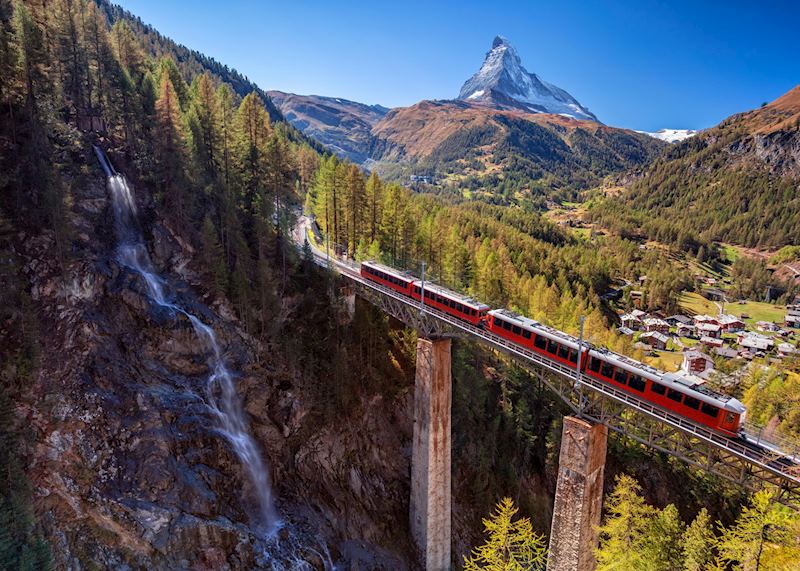
There are many reasons to plan a visit Switzerland: mountain panoramas and Alpine lakes, creamy cheeses and rich chocolates, rare wines, and plentiful hiking trails. On a trip, you can easily hop between the Swiss lakeside cities, storied resort towns, and pastoral dairy villages, all connected by efficient luxury trains and some of the best hiking in Europe.
Where this trip might take you:
The country has several large cities with international airports, including Geneva, Zürich, and Lugano on the border with Italy. Connected by an efficient network of trains, they are easy to hop between. The trains can also take you up into the most renowned mountains in Europe — Mont Blanc, the Matterhorn, and Jungfrau.
Experiences you can have:
Take in the endless views of the Matterhorn from the hiking trails through Zermatt and see the sweeping panoramas of the Mont-Blanc and Jungfrau peaks from the Glacier 3000, a scenic lookout high in the mountains that you reach by funicular.
You’ll also have the chance to cruise along the glass-smooth Lake Geneva on a wooden boat. Soak up the sunshine as you explore the medieval villages and estates that dot the lake’s shoreline with an expert captain.
No trip to Switzerland is complete without enjoying the country’s renowned cheese and chocolate. Visit a traditional Alpine farm to see where the cows live and enjoy a guided tasting. You’ll also take a private food tour through Lugano, sampling cured meats, regional cheese, sweet treats, and some of Switzerland’s wine.
9. Royal Scotland & Ireland

Both Scotland and Ireland are replete with castles and grand manor houses, including many that have been converted into luxe hotels. Whether you’re in the historic cities, visiting bucolic villages, or exploring the countries’ landscapes, you can spend your trip here delving deep into the different cultures, while relaxing in a style fit for a lord.
Where this trip might take you:
Both Dublin and Edinburgh are built on medieval cores and have international airports, making them good places to start or end your trip. To explore the Highlands north of Edinburgh or the counties west of Dublin, you can opt for a private driver-guide, especially to reach the more far-flung castles. To get between the two countries, a short flight is the fastest option.
Experiences you can have:
We can arrange private tours of castles across the two countries, including Edinburgh, Scone Palace, Urquhart, Eilean Donan, and Blarney Castle, where you can kiss the Blarney Stone itself. You can also take an after-hours tour of Dunvegan Castle once all the other visitors have gone home — the caretaker will tell you stories from the McLeod clan’s history and share a wee dram of whisky.
Along the way, you’ll spend the night at a variety of opulent hotels that are set in converted castles and grand manors, including Culloden House, as well as Fonab, Inverlochy, and Dromoland castles.
Private guides will also tell you the history and myths around some the countries’ most storied landscapes, from the misty dales of the Isle of Skye to the dark depths of Loch Ness to the wave-lashed shores of the Dingle Peninsula.
Edinburgh has a thriving culinary scene that you can explore on a walking tour that includes whisky, local gins, artisanal cheese, handmade chocolates, and even a few traditional dishes like haggis and ”neeps and tatties” (turnips and potatoes).
10. Croatia's Dalmatian Coast

The Dalmatian Coast isn’t just Croatia’s best coastline, it’s among the Mediterranean's best coastlines. On a trip that focuses on its southern stretch, you can jump easily between the star attractions of Split and Dubrovnik and the islands, sipping local wines, kayaking through blue water, and relaxing under the reliable Dalmatian sun as you go. Exploration and relaxation come in equal measure here.
Where the trip could take you:
Split and Dubrovnik are the main cities — each with a medieval heart — and you can fly into one and out of the other. Between the two, you’ll have the chance to enjoy the islands and the water. Split connects by ferry to the island of Hvar, which in turn connects to the island of Korčula. From here, it’s another ferry across to Dubrovnik.
What to experience along the way:
Expert guides can take you through the Roman-era Diocletian’s Palace in Split and Dubrovnik’s marble-paved medieval Old Town.
The Dalmatian Coast is one of the sunniest places in Europe. You can embrace the abundant blue skies with guided outdoor adventures like kayaking around the Pakleni Islands, just off Hvar, or hiking through Krka National Park to admire the many waterfalls.
If you simply can’t get enough of the waters, we can arrange a cruise around the Elaphiti Islands, a tiny archipelago off Dubrovnik where you can snorkel and swim.
And, the region gives you plenty of opportunities to sample Croatia’s wine and food. We can set up a private tasting at one of Hvar’s best wineries or at an oyster farm in the town of Ston.
11. Southern Spain

Once home to great Moorish kingdoms, sunny Andalusia is a great place to explore the region’s singular melding of cultures. On a trip here, you can easily hop between grand palaces and intimate, hand-on experiences of cultural influences, like cooking classes, flamenco performances, and wine tastings.
Where the trip could take you:
Seville, Córdoba, and Granada were once the leading lights of Europe and remain excellent destinations for exploring the Moorish legacy. You can also use them as a base for exploring the countryside around the cities. From there, you might want to end with a few days relaxing on a beach in Marbella.
What to experience along the way:
In Córdoba’s Mezquita and the sprawling Alhambra Palace in Granada, you’ll have expert guides who’ll help you understand how the extraordinary architecture illustrates the history of these two buildings. While in Seville, you can see the Alcázar and Giralda Tower from inside a horse-drawn carriage.
Attend a small flamenco performance so you might enjoy the passionate music while eating tapas. Or for a more in-depth look at regional cuisine, we can arrange for you to visit Jabugo, just outside Seville, to see where jamón Ibérico is made. You might also wish to take a tour and tasting of a sherry producer or try your hand at Andalusian food with a cooking class.
Outside the cities, you can follow a guide on a leisurely hike among the Alpujarras to see the whitewashed villages that still thrive there.
12. Winter in Iceland
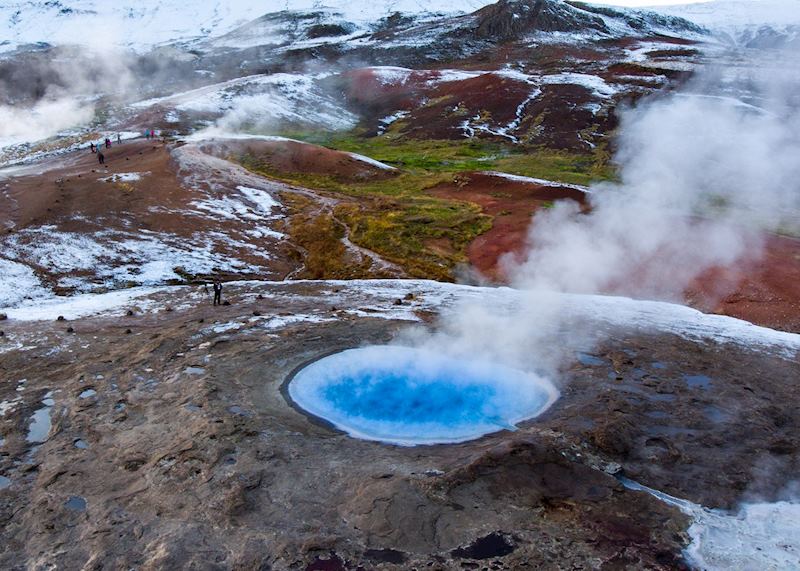
The Land of Fire and Ice really shines in winter — literally. A visit here dramatically improves your chances of seeing the northern lights’ cosmic show. You might glimpse them from your hotel, perched on Iceland’s south coast, or while riding a Superjeep into the interior, far from any light pollution.
Where the trip could take you:
All international trips to Iceland start in Keflavík Airport, the international airport outside the capital of Reykjavík. From there, you’re well positioned to explore the South Coast, including a guided tour of the area’s many waterfalls, like Skógafoss and Seljalandsfoss, as well as the black-sand beach of Reynisfjara.
What to experience along the way:
During the day, explore the rugged terrain with expert guides who can help you safely navigate them, as well as explain the primal forces that have created the landscape. You’ll hike across Sólheimajökull glacier, watch geysers erupt at Geysir, and even walk along the fault where the tectonic plates are slowing — tearing apart the crust of the earth itself — in Þingvellir National Park.
You can also take an Icelandic cooking class to learn how to cook traditional Icelandic dishes while hearing how they relate to the Icelandic sagas.
Or you might embrace the fiery side of the country by including a visit to the LAVA Centre, a trip down into the throat of Þríhnúkagígur (an extinct volcano), or spend the day soaking in the naturally steamy waters of the Geosea hot springs.
13. Germany: Bavaria & the Romantic Road

Nowhere does the Grimms' Fairy Tales version of Germany seem more alive than in the Bavarian towns and villages along the Romantic Road. The route culminates at the fairytale-like towers and spires of Neuschwanstein Castle, built to suit the tastes of the eccentric Ludwig II.
Where the trip could take you:
You can fly into Berlin to include time in the capital, before heading south to the Romantic Road via Nuremberg. Along the way, you can stop at Munich, Freiburg, and Heidelberg to round out your introduction to this part of Germany. Frankfurt — and its international airport — are a good place to end the trip.
What to experience along the way:
In Freiburg, take a private guided tour of the market, sampling sausages and cheese while browsing through the local crafts. You can also explore medieval villages along the Romantic Road, where the cobblestone streets are lined with half-timbered houses. Additionally, this part of the country is filled with breweries where you can enjoy the beer that Germany’s known for.
In Munich, a private guide can reveal the country’s turbulent 20th-century history on a walking tour, while in Nuremburg, your guide might help you explore the red sandstone tunnels under the old town.
If you want to delve more deeply into the Rhine Valley, you can include a leisurely cruise and driving tour. Covering land and water, this tour enables you to see castles around every bend, takes you on a cable car for a sweeping view, and leads you to the cobbled streets of Rüdesheim.
Read more about trips to Europe
Start thinking about your experience. These itineraries are simply suggestions for how you could enjoy some of the same experiences as our specialists. They're just for inspiration, because your trip will be created around your particular tastes.
View All Tours in Europe

